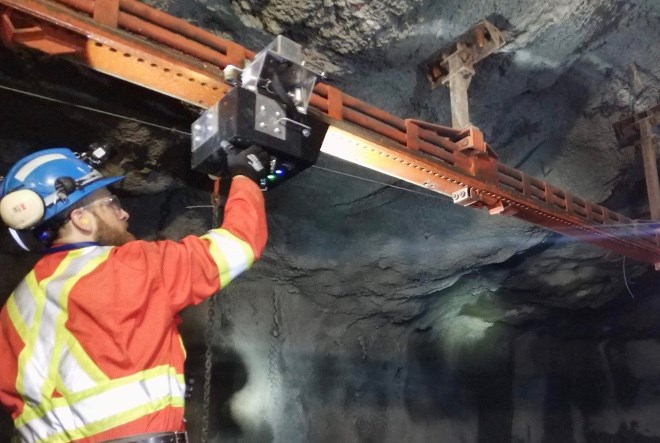Combining old technology with modern robotics has resulted in a new safety innovation for underground mines that's expected to reduce risk and improve efficiency.
The MRC Rail Runner, developed by SafeSight Exploration Inc. of North Bay, is a utility robot clamped onto a mechanized rail climber (MRC), which is sent up into a raise to do an inspection.
The robot is designed to replace humans who are required to visually inspect the raise for potential risks like loose rock.
In underground mining, a raise is a vertical underground excavation, running between various levels, that's used for ventilation to the surface or for transporting ore and waste rock.
“Provincial regulations say that, every shift, the environment must be assessed or observed, and that meant sometimes travelling a couple hundred feet inside the raise to assess any inherent danger in this rock,” said Mike Campigotto, SafeSight’s president.
“That meant putting a human being at risk to visually inspect, and there wasn't any alternative for that.”
With the MRC Rail Runner, the robot enters the raise, records video, and returns to the operator, effectively completing the required inspection without the worker ever having to enter the raise.
Want to read more stories about business in the North? Subscribe to our newsletter.
SafeSight took the lead on this project after being approached by North Bay-based mine builder Redpath Mining last November.
The two companies had collaboratively worked before on SafeSight’s underground drone inspection technology for stopes and other survey work. The drone is equipped with light detection and ranging (LiDAR) technology, and high-definition cameras.
But it was too costly and impractical to send a drone into a raise for every single inspection, said Stephen Korski, Redpath's manager of research and development.
Redpath wondered if the technology could be adapted to a mechanized rail system instead.
“We had tried thinking of a way you could do it where you didn’t need a person to up there at all, and that’s what prompted the whole thing,” Korski said.
“From an R&D perspective, we try to find something that works in another industry or is already out there and see if we can adapt it to our use.”
Mechanized rail systems were first introduced underground in the 1970s as a safer, more efficient method for advancing mine development.
The rails, bolted onto the wall of a stope, can carry a cage for two miners and equipment. When they arrived at the face, the cage opens out as a work platform.
As contractors started using more modern technology, like raise boring machines, mechanized rail systems fell out of favour and are now considered somewhat of a “sunset industry,” Korski said.
But paired up with SafeSight’s robotics, the rail system is once again offering a safer and faster solution in underground development.
“If I'm a supervisor getting in the cage to go up the rail, and I've got 100 feet of development done, that's probably half an hour, maybe 45 minutes by the time I go to the top,” Campigotto said.
“The Rail Runner could do it in seven or eight minutes.”
Operation of the Rail Runner requires very little training, he noted. The operator simply clamps the unit onto the rail and then uses a tablet to control it.
It can be sent up to inspect the entirety of the raise, taking video during the full trip, or it can be instructed to go directly to the top, take 30 seconds’ worth of images, and then return to the point of origin. The images and videos are time-stamped and can be downloaded onto a USB drive for review.
Work on the project began in November, 2018, and it was ready for field testing by early spring, a timeline Campigotto and Korski agree is “unprecedented” for an R&D project.
The quick turnaround was thanks, in part, to SafeSight’s existing software technology, which the company was able to customize for an alternative use.
“As a technology company, we’ve been very intentional about creating a unit that can plug and play into each other,” Campigotto said. “So a lot of our technology is designed like a kit of Legos where we can take pieces off and put new pieces on and still leverage a lot of the existing components that are in the core framework.”
Redpath’s personnel put the technology through its paces, testing it on old, beat-up track, evaluating the quality of the video, and looking for any bugs in the system.
Currently, the companies are figuring out a mechanism that would allow the power to be shut off remotely should the robot get stuck.
Otherwise, Korski said, Redpath has been pleased with the outcome.
“We have a high-resolution 1080p (high-definition) video; we have better than adequate lighting; we've addressed issues of getting stuck…. It's really come together," he said.
The last step is getting buy-in from the Ministry of Labour.
SafeSight is in the process of setting up a field exercise for the ministry, with the hope that images provided by the Rail Runner will meet government standards.
Meanwhile, SafeSight is already working on version 2.0 of the unit, which will include LiDAR technology so that the robot can automatically survey the raise as it’s performing the inspection. The company is already demonstrating this to other mining companies.




